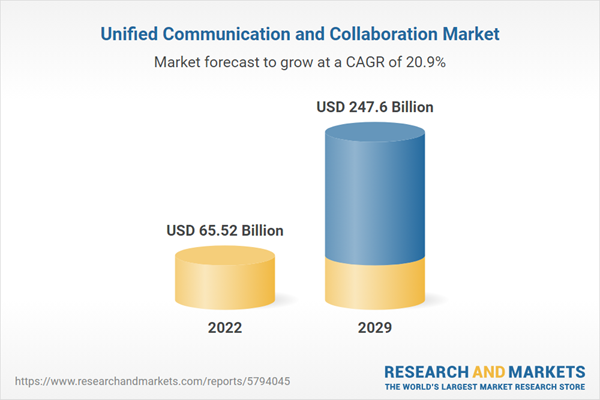The unified communication and collaboration market is projected to grow at a CAGR of 20.91% to reach US$247.601 billion in 2029 from US$65.523 billion in 2022.
The compilation of various software and technological applications that integrate workplace communication with live and sequential cooperative capabilities are referred to as unified communication and collaboration (UC&C) solutions. They unify numerous techniques utilized in individual units of UC&C services and solutions to promote accessibility through one platform to enhance efficiency and connectivity.
Integrating collaboration and communication features into a single accessible platform facilitates teamwork, increases accessibility and flexibility, enhances user experience, and aids in improving responsiveness. In addition, UC&C solutions aid organizations in streamlining their communication and collaboration processes by integrating various communication channels, such as voice, video, and messaging, into a single platform enabling employees to communicate more effectively and reducing the time spent switching between different tools.
Globally, 79% of individuals aged 15 to 24 utilize the internet, which is 14 percentage points higher than the usage among the broader population (65%). This generational gap has remained consistent over the past four years and is evident across all regions. The increasing demand for technologies facilitating smooth communication and collaboration across departments and geographical locations is fueling the need for UC&C solutions.
This marks a demand for more effective and reduces the time spent switching between different tools which leads to the growth of unified communication and collaboration (UC&C) solutions.
According to Eurostatis, in 2022, 50% of enterprises with 10 or more employees or self-employed persons conducted remote meetings via the Internet in the European Union. The largest shares among European countries were registered in Sweden at 79.4% and Finland at 78.5%, with Denmark closely following at 78.0%. Malta and Ireland stand at 68.3% and 63.6%, respectively.
Furthermore, implementing a remote work practice is stimulating companies such as Amazon Web Services, Google, Spotify, and Dell Technologies to develop hybrid and long-term remote work models. Therefore, the changes in corporate work demographics are generating demand for collaborations and communications tools among different departments in an organization. This is a significant factor expected to stimulate the growth of the UC&C market over the forecast period.
The compilation of various software and technological applications that integrate workplace communication with live and sequential cooperative capabilities are referred to as unified communication and collaboration (UC&C) solutions. They unify numerous techniques utilized in individual units of UC&C services and solutions to promote accessibility through one platform to enhance efficiency and connectivity.
Integrating collaboration and communication features into a single accessible platform facilitates teamwork, increases accessibility and flexibility, enhances user experience, and aids in improving responsiveness. In addition, UC&C solutions aid organizations in streamlining their communication and collaboration processes by integrating various communication channels, such as voice, video, and messaging, into a single platform enabling employees to communicate more effectively and reducing the time spent switching between different tools.
Globally, 79% of individuals aged 15 to 24 utilize the internet, which is 14 percentage points higher than the usage among the broader population (65%). This generational gap has remained consistent over the past four years and is evident across all regions. The increasing demand for technologies facilitating smooth communication and collaboration across departments and geographical locations is fueling the need for UC&C solutions.
Unified communication and collaboration market drivers:
Advancements in 5G network and wireless technology:
The advancement of wireless technology and the expansion of internet access globally are driving the adoption of UC&C software and applications. These solutions offer users faster and improved communication systems, enhancing worldwide connectivity. According to the ITU, nearly 40% of the world is now covered by 5G networks. ETNO's latest State of Digital Communications report indicates that 5G coverage in Europe reached 73% in 2022, marking an 11% increase from 2021. In comparison, 5G coverage is at 96% in the USA, 95% in South Korea, 90% in Japan, and 86% in China.This marks a demand for more effective and reduces the time spent switching between different tools which leads to the growth of unified communication and collaboration (UC&C) solutions.
The growing demand for remote work practices
The rise of remote work is growing the demand for tools that enable remote collaboration, such as UC&C solutions that provide a unified platform for employees to communicate and collaborate from any location or device by utilizing efficient internet and wireless technology.According to Eurostatis, in 2022, 50% of enterprises with 10 or more employees or self-employed persons conducted remote meetings via the Internet in the European Union. The largest shares among European countries were registered in Sweden at 79.4% and Finland at 78.5%, with Denmark closely following at 78.0%. Malta and Ireland stand at 68.3% and 63.6%, respectively.
Furthermore, implementing a remote work practice is stimulating companies such as Amazon Web Services, Google, Spotify, and Dell Technologies to develop hybrid and long-term remote work models. Therefore, the changes in corporate work demographics are generating demand for collaborations and communications tools among different departments in an organization. This is a significant factor expected to stimulate the growth of the UC&C market over the forecast period.
Unified communication and collaboration market challenges:
The technical restraints associated with a unified communication and collaboration system could limit the market's growth.
Any technical disturbances, such as poor network connectivity, low bandwidth, and hardware failures, can disrupt communication and collaboration, leading to communication breakdowns and lost productivity. In addition, complications associated with merging the UC&C system with various enterprise applications, such as CRM, ERP, and HR systems, with providing a seamless experience pose a threat to companies' extensive adoption of UC&C. Further, the inefficiencies existing in current UC&C products are also restraining market growth.By service, the UCaaS segment is expected to hold a prominent share of the unified communication and collaboration market.
UCaaS solutions refer to unified communications as a service that has the potential to support six functions related to communication. These solutions are generating a high demand for consumer companies. It is utilized by enterprises, for chat, voice, video, or collaboration. It can be utilized for reduced costs, scalability, improved productivity, and flexibility. It helps to be competitive even in times of uncertainty. Hence, the rising demand for UCaaS applications is expected to witness its share increase in the uc&c market over the forecast period.North America will retain a prominent share of the unified communication and collaboration market in the forecast period.
The extensive application of UC&C solutions across different industries, including retail, education, BFSI, healthcare, and government departments in North American countries such as the US, and the rising investment in the development of UC&C solutions by leading companies in the IT sector, such as Google and IBM are contributing to the expansion of UC&C market in the region. A survey conducted by Netscout Company revealed that 75% of the US and Canadian businesses with over $1 billion in annual revenue increased their usage of UC&C products in 2022.Unified communication and collaboration market Industry Updates:
- July 2023- Alcatel-Lucent Enterprise, launched Alcatel-Lucent Enterprise Rainbow™ Hub in the UK, combining its popular Unified Communications (UC) and PBX solutions in a fully cloud-based service. This all-encompassing Unified Communications as a Service (UCaaS) solution empowers end users with a cloud-based platform while allowing channel partners to provide advanced services without the burden of managing operations complexities.
- April 2023-BCM One, disclosed a definitive agreement, subject to regulatory approvals, to acquire Pure IP, a voice provider based in the U.K. This acquisition aims to enhance BCM One's NextGen Communications portfolio, enabling it to deliver enterprise-grade cloud-based voice solutions for Microsoft Teams, Cisco Webex, and Zoom to global businesses.
- November 2021- Tata Communications, introduced a new UCaaS software platform, GlobalRapide, to provide enhanced collaboration experiences among employees of its client companies.
Unified Communication And Collaboration Market Players and Products:
Unified Communications as a Service (UCaaS) by Microsoft- Unified Communications as a Service (UCaaS) integrates various applications and services such as calling, chatting, video conferencing, and audio conferencing into a single cloud-based platform. Microsoft Teams simplifies collaboration by offering online meetings, audio and video calling, chat, file sharing, and storage - all accessible from anywhere through a unified and streamlined user interface.Unified Communication And Collaboration Market is segmented and analyzed as below:
By Service
- UCaaS
- CPaaS
- Managed UC Services
- Audio, Web, and Video Conferencing Services
- VoIP Access and SIP Trunking
By Deployment
- Cloud
- On-premise
By Industry Vertical
- Retail
- BFSI
- Education
- Healthcare
- Government
- Others
By Geography
- North America
- USA
- Canada
- Mexico
- South America
- Brazil
- Argentina
- Others
- Europe
- Germany
- France
- UK
- Spain
- Others
- Middle East and Africa
- Saudi Arabia
- UAE
- Israel
- Others
- Asia Pacific
- China
- Japan
- India
- South Korea
- Indonesia
- Taiwan
- Others
Table of Contents
1. INTRODUCTION
2. RESEARCH METHODOLOGY
3. EXECUTIVE SUMMARY
4. MARKET DYNAMICS
5. UNIFIED COMMUNICATION AND COLLABORATION MARKET BY SERVICE
6. UNIFIED COMMUNICATION AND COLLABORATION MARKET BY DEPLOYMENT
7. UNIFIED COMMUNICATION AND COLLABORATION MARKET BY INDUSTRY VERTICAL
8. UNIFIED COMMUNICATION AND COLLABORATION MARKET BY GEOGRAPHY
9. COMPETITIVE ENVIRONMENT AND ANALYSIS
10. COMPANY PROFILES
Companies Mentioned
- IBM Corporation
- Microsoft
- Zoom Video Communications, Inc
- Cisco Systems, Inc.
- RingCentral, Inc.
- Verizon
- VONAGE
- Avaya Inc.
- 8x8, Inc.
- Google LLC
Methodology

LOADING...
Table Information
| Report Attribute | Details |
|---|---|
| No. of Pages | 145 |
| Published | May 2024 |
| Forecast Period | 2022 - 2029 |
| Estimated Market Value ( USD | $ 65.52 Billion |
| Forecasted Market Value ( USD | $ 247.6 Billion |
| Compound Annual Growth Rate | 20.9% |
| Regions Covered | Global |
| No. of Companies Mentioned | 10 |









